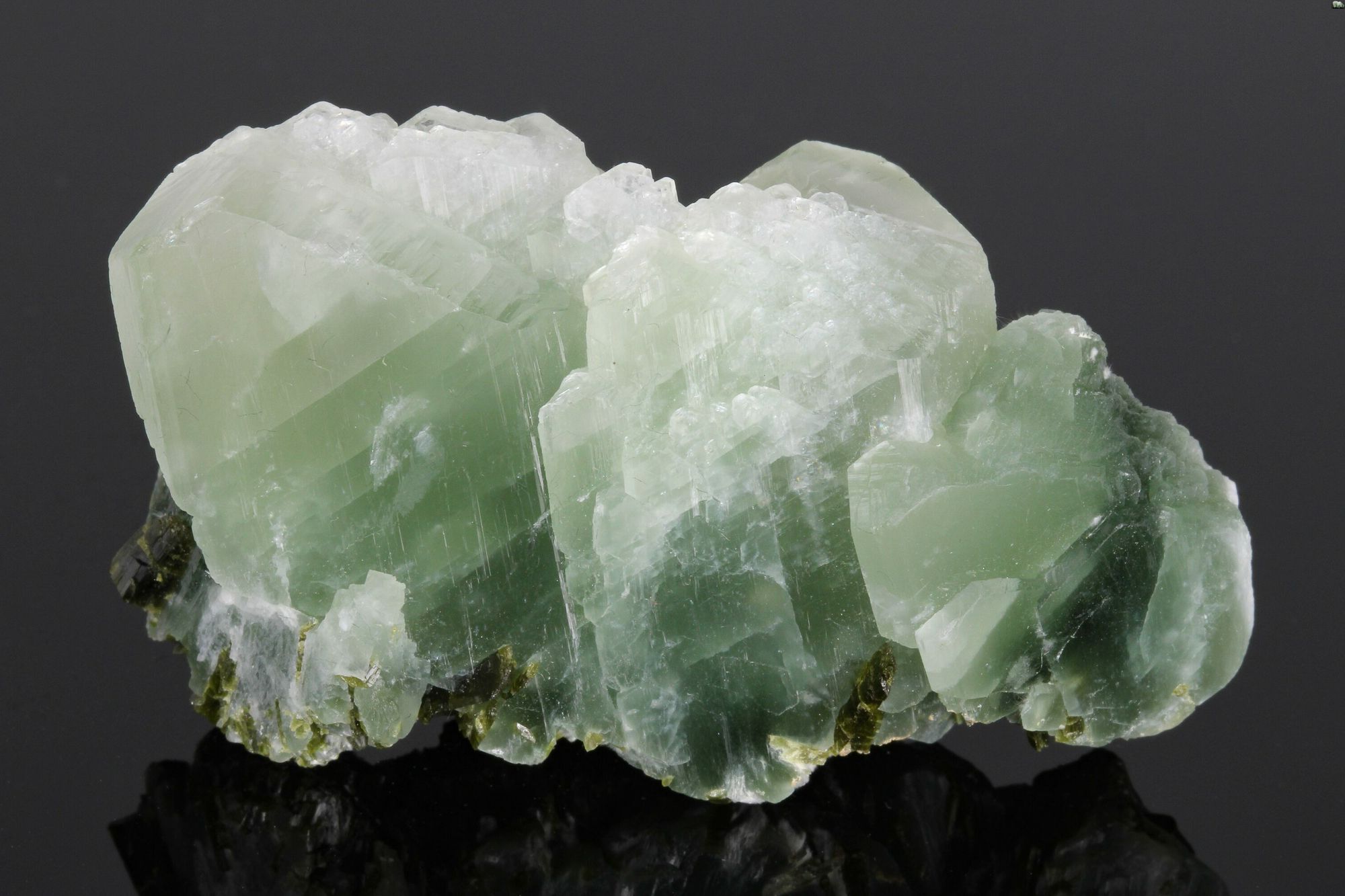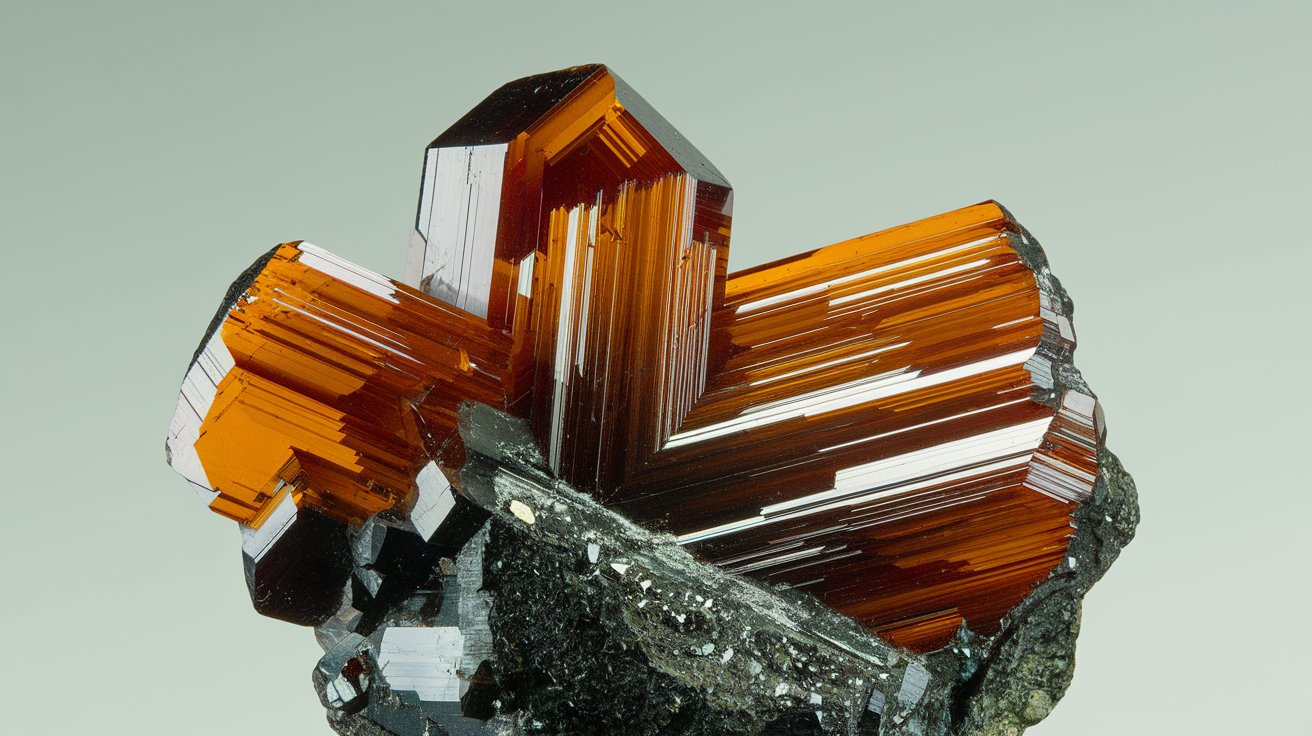
What is albite? Albite is a fascinating mineral that belongs to the feldspar group, one of the most common minerals in the Earth's crust. Its name comes from the Latin word "albus," meaning white, which reflects its typical color. However, albite can also appear in shades of yellow, pink, gray, and reddish. With a chemical formula of NaAlSi₃O₈, albite contains sodium, aluminum, silicon, and oxygen. This mineral is known for its unique physical properties, including a hardness of 7 on the Mohs scale and a triclinic crystal structure. Found in igneous and metamorphic rocks, albite has various industrial applications and even some metaphysical significance.
Key Takeaways:
- Albite is a versatile mineral with unique optical properties and is commonly found in igneous and metamorphic rocks. It is used in various industries and has metaphysical significance, making it a fascinating subject for study and collection.
- With a chemical formula of NaAlSi₃O₈, albite is known for its hardness, birefringence, and luminescent properties. It is used in glass, ceramics, and enamel production, and is believed to have healing and metaphysical benefits.
What is Albite?
Albite is a fascinating mineral that belongs to the feldspar group, one of the most common minerals in the Earth's crust. Its name comes from the Latin word "albus," meaning white, which is a common color for this mineral. However, albite can also appear in various other shades. Let's dive into some intriguing facts about albite.
-
Chemical Formula
Albite's chemical formula is NaAlSi₃O₈. This indicates it contains sodium (Na), aluminum (Al), silicon (Si), and oxygen (O) in its crystal structure. -
Physical Properties
Albite has a density range of 2.61 to 2.63 grams per cubic centimeter, making it slightly heavier than water. It can be transparent, translucent, or subtranslucent, appearing clear or slightly cloudy. -
Hardness
With a hardness of 7 on the Mohs scale, albite is as hard as quartz. This makes it relatively durable but not as hard as corundum or diamond. -
Fracture
The fracture of albite is uneven, meaning it breaks with rough, irregular surfaces rather than smooth planes. -
Habit
Albite often forms blocky crystals, which are roughly the same size in all dimensions. It can also appear as anhedral to subhedral crystals in a matrix, sometimes displaying striated surfaces with parallel lines.
Optical and Luminescent Properties
Albite has unique optical and luminescent properties that make it useful in various studies and applications.
-
Optical Properties
Albite exhibits birefringence, meaning it has different refractive indices for different polarizations of light. This property is useful for optical studies. The indices for albite are typically in the range of 1.530 to 1.540. -
Luminescence
Albite is fluorescent under short ultraviolet light, emitting light when exposed to UV radiation. This property can help identify albite under specific lighting conditions. -
Radioactivity
Albite is not radioactive, as indicated by its gamma-ray activity index (GRapi) being zero. This makes it safe for handling and use in various applications.
Geological Occurrences and Industrial Applications
Albite is found in various geological settings and has numerous industrial applications.
-
Geological Occurrences
Albite is commonly found in igneous rocks like granite and pegmatites. It is also present in metamorphic rocks such as gneiss and marble, making it one of the most widespread minerals in the Earth's crust. -
Industrial Applications
Albite is used in the production of glass, ceramics, and enamel. It is also utilized in the paint, rubber, and plastic industries due to its ability to form stable compounds with various elements.
Albite as a Gemstone
Though not commonly used as a gemstone, albite has some unique applications in jewelry.
-
Gemstone Use
Albite can be found in some jewelry as a substitute for more expensive stones. It is sometimes intergrown with emeralds, particularly in the unique hexagonal skeletal crystals known as trapiche emeralds. -
Varieties of Albite
Albite can occur in various colors, including white, yellow, pink, gray, and reddish. Translucent albite can sometimes be colored green by inclusions of chrome-rich jadeite. It is also known to form moonstones, which display a blue or white adularescence under certain conditions.
Crystal Structure and Modifications
Albite's crystal structure and modifications are influenced by temperature and pressure conditions during its formation.
-
Crystal Structure
Albite has a triclinic crystal structure, meaning its unit cell is not a perfect cube or other simple shape. -
Low and High Temperature Modifications
Albite exists in two structural modifications: low albite and high albite. Low albite is stable at lower temperatures, while high albite is stable at higher temperatures. -
X-Ray and Neutron Diffraction Studies
Several studies using X-ray and neutron diffraction have analyzed albite's crystal structure, providing detailed information about its atomic arrangement and bonding patterns.
High-Pressure and Hydration Reactions
Albite undergoes significant changes under high-pressure conditions and hydration reactions.
-
Order-Disorder Process in Tetrahedral Sites
Albite undergoes an order-disorder process in its tetrahedral sites, influenced by temperature and pressure conditions. -
High-Pressure Crystal Chemistry
Under high-pressure conditions, albite's crystal chemistry changes significantly, breaking down into other minerals like sodium chloride and potassium chloride. -
Hydration Breakdown Reaction
When subjected to hydrous cold subduction conditions, albite breaks down into hydrated smectite clay, releasing sodium and hydroxide ions into the surrounding fluid medium. -
Scanning Electron Microscopy and FT-IR Measurements
Scanning electron microscopy (SEM) and Fourier Transform Infrared Spectroscopy (FT-IR) measurements have confirmed the hydration breakdown reaction of albite, revealing its transformation into smectite clay and the release of alkaline species.
Metaphysical Properties and Historical Significance
Albite is believed to have powerful metaphysical properties and has a rich historical significance.
-
Metaphysical Properties
Albite is said to promote healing, clarity, and understanding. It is also believed to help connect individuals with divine energies during meditation or prayer rituals, often associated with the crown chakra. -
Medical Benefits
Albite is thought to increase energy levels and promote overall well-being. It is also believed to help alleviate physical pain and discomfort. -
Historical Significance
Discovered by Johan Gottlieb Gahn in 1815, albite has been extensively studied for its crystal structure and mineral properties. It has been used for various applications, including decorative stone materials and ceramics production.
Notable Localities and Unique Optical Properties
Albite is found in various notable localities and has unique optical properties that make it interesting for collectors.
-
Abundance in Granite Deposits
Albite is particularly abundant in areas with granite deposits, such as Scandinavia and North America, making it a significant component of many geological formations. -
Unique Optical Properties
Albite often appears milky white when polished or cut but may display shades of pink or yellow depending on how it’s handled. -
Gemstone Identification
Albite can be identified by its physical properties such as density, hardness, and optical characteristics. Inclusions like chrome-rich jadeite can color the mineral green.
Facetable Albite and Moonstones
Facetable albite and moonstones are unique and highly valued by collectors.
-
Facetable Albite
Facetable albite from Madagascar has specific indices: a = 1.530-1.531, β = 1.532-1.533, and γ = 1.539-1.540. It also exhibits birefringence of 0.009-0.010 and a density of 2.62. -
Small Faceted Gems
Small faceted gems of albite are rare and almost always found at the tips of cleavelandite crystals. These gems are usually colorless and not particularly exciting to look at. -
Albite Moonstones
Albite moonstones are known from many localities. These moonstones display a blue or white adularescence under certain lighting conditions, making them unique gemstones.
Notable Localities for Albite
Several localities around the world are known for producing high-quality albite crystals.
-
Rutherford Mine, Amelia, Virginia
The Rutherford Mine in Amelia, Virginia, produces fine colorless albite that is facetable and large. The crystals from this mine are often platy and known as cleavelandite. -
Upson County, Georgia
Upson County in Georgia is another locality where moonstone albite is found. These moonstones are highly prized for their unique optical properties. -
South Dakota
South Dakota is also a significant locality for cleavelandite albite. The crystals found here are often colorless with a slight blue or yellow tinge. -
Brazil
Brazil is known for producing cleavelandite albite. The crystals from this region are highly sought after by collectors due to their unique characteristics. -
Kenya
Kenya is another country where colorless albite crystals are found. Some of these crystals display a blue or yellow tinge, making them highly valuable.
Notable Collections and Contributions
Albite has been featured in notable collections and has had significant contributions from experts in the field.
-
Royal Ontario Museum (Toronto, Ontario, Canada)
The Royal Ontario Museum in Toronto, Ontario, Canada, has a notable collection of catseye albite. One of the most notable pieces is a 12.25-carat catseye albite from Burma. -
Devonian Group (Calgary, Alberta, Canada)
The Devonian Group in Calgary, Alberta, Canada, is another significant locality for catseye albite. One notable piece is an 11.13-carat white catseye albite. -
Joel E. Arem’s Contributions
Dr. Joel E. Arem, a renowned expert in mineralogy and gemology, has contributed significantly to the understanding of albite. He has published numerous books and has been involved in various organizations related to gemstones and minerals.
Albite in Jewelry and Metaphysical Significance
Albite's unique properties make it an interesting choice for jewelry and metaphysical practices.
-
Albite in Jewelry
While albite is not commonly used in jewelry, it can be found in some pieces as a substitute for more expensive stones. Its unique optical properties make it an interesting choice for collectors and enthusiasts. -
Trapiche Emeralds
Albite is sometimes intergrown with emeralds, particularly in the unique hexagonal skeletal crystals known as trapiche emeralds. This combination makes these emeralds highly valuable and sought after by collectors. -
Metaphysical Significance
Albite is believed to have metaphysical significance, promoting healing, clarity, and understanding. It is also believed to help connect individuals with divine energies during meditation or prayer rituals. -
Conclusion
Albite is a versatile mineral with a wide range of applications, from industrial uses to metaphysical significance. Its unique physical properties and geological occurrences make it an interesting subject for study and collection. Whether it is used in glass manufacturing or as a gemstone, albite remains an important mineral in the world of geology and mineralogy.
Albite: A Versatile Mineral
Albite stands out as a versatile mineral with a wide range of applications and fascinating properties. From its chemical formula NaAlSi₃O₈ to its hardness of 7 on the Mohs scale, albite is both durable and intriguing. Found in igneous rocks like granite and pegmatites, as well as metamorphic rocks such as gneiss and marble, albite is abundant in the Earth's crust. Its industrial uses span from glass and ceramics production to applications in the paint, rubber, and plastic industries.
Albite's unique optical properties make it interesting for gemstone collectors, especially in the form of moonstones and trapiche emeralds. Its metaphysical significance adds another layer of interest, believed to promote healing and clarity. Whether you're a geologist, a gem enthusiast, or someone interested in metaphysical properties, albite offers something for everyone. This mineral truly is a gem in the world of geology and beyond.
Frequently Asked Questions
Was this page helpful?
Our commitment to delivering trustworthy and engaging content is at the heart of what we do. Each fact on our site is contributed by real users like you, bringing a wealth of diverse insights and information. To ensure the highest standards of accuracy and reliability, our dedicated editors meticulously review each submission. This process guarantees that the facts we share are not only fascinating but also credible. Trust in our commitment to quality and authenticity as you explore and learn with us.


